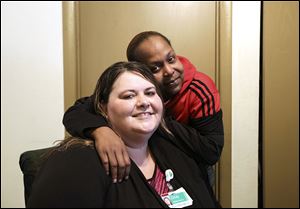
COMMUNITY HEALTH FIELD
Workers reach out, help clients locate resources
1/10/2017Kim Fitzpatrick gets teary talking about the help she’s gotten thanks to a community health worker.

Community health worker Cindy Meeker gets a hug from Kim Fitzpatrick who says ‘I probably would be back in the hospital if it wasn’t for her.’
Sitting in her West Toledo apartment, the 43-year-old single mother and three-time stroke and heart attack survivor recounts the difference Cindy Meeker, a community health worker with ProMedica, has made: helping her find food assistance after a year of hospitalization; untangling a devastating identity theft that wiped out everything she had; being there to talk.
“I probably would be back in the hospital if it wasn’t for her,” she said. “She’s really like family to me now.”
The community health worker profession is gaining recognition as a vital connection between traditional health care and communities that lack access to other basic resources such as food and transportation. They target populations at risk for falling through the cracks — low-income clients, those with chronic disease, pregnant women, or communities with language barriers.
In northwest Ohio, the profession started with the Pathways HUB through the Hospital Council of Northwest Ohio working with expectant mothers identified as at risk for premature birth or infant mortality. Now, community health workers are employed by major hospital systems, small nonprofits, and advocacy groups alike.
“It’s a front-line public health worker, someone who is going to be out in the community not behind a desk, finding people where they are,” said Jan Ruma, vice president of the hospital council and director of the Pathways HUB. “An ideal community health worker is someone from that community who can relate — not a white coat who is unapproachable, but someone who you could sit across the table from and talk to.”
For medical professionals who have never personally experienced poverty, it can be hard to understand why a patient might miss a critical appointment or not fill their prescriptions, Ms. Ruma said. A community health worker might see that the patient doesn’t have reliable transportation or child care, or that they are having to choose between buying groceries and paying for medications.
A growing field
The field is growing in popularity as a cost-efficiency effort to prevent serious health problems rather than treating them once they occur. The Affordable Care Act provided incentives to increase the role of community health workers when caring for Medicaid patients.
“The concept is taken from early days of public health nursing and going door-to-door doing immunizations,” Ms. Ruma said. “We’re getting back to getting one-on-one with people. Everything old is new again.”
Requirements and responsibilities vary by state, but in Ohio community health workers are certified with the Ohio Board of Nursing. The profession is growing, said Tim Christman, program lead for the community health worker program at Mercy College of Ohio, which offers one of the training programs in northwest Ohio.
“There is a big need for people doing this type of casework to fill some of the void of health care and patient care,” he said.
Locally, there are a few programs to be certified; training includes a classroom portion and clinical practice hours. Tuition stipends from the Ohio Colleges of Medicine Government Resource Center are now available for a program beginning in March on the University of Toledo Health Science Campus.
Applications are available on the Hospital Council’s website, hcno.org, and are due Wednesday. There is funding available for 22 stipends.
‘More than just a job’
Ms. Meeker learned about the job through a friend. She was certified last year and said it’s a way to connect with people and make a difference.
She opens up a tablet to show the program that allows her to track appointments with her clients and link them to resources. Most clients come through doctor referrals, and she meets them in the doctor’s office or at their homes.
“I enjoy people so being able to be there to figure things out for people, and meeting people like Kim, it’s more than just a job,” she said. It’s a common refrain.
Erin Hatch, 37, works at the East Toledo Family Center. She said she was drawn to working at the center after recognizing the sacrifices her own mother made as a single mom, and realizing what a little extra help can do for families.
“The ultimate goal is healthy pregnancies, healthy birth weight babies,” she said. She works to make sure women get to prenatal appointments and have the tools they need before and after the baby is born.
“We have a lot of moms that don’t have any social support, don’t have a relationship with their families,” she said.
Tara Hayes has been a community health worker since 2005, when she started working with pregnant women. Ms. Hayes, 46, could relate.
“My interest [in the career] grew because I was a teen mom; by 16, I had two kids,” said Ms. Hayes, now at Mercy Health working with adults with chronic diseases. “The need for not only health care, but resources in the community, really drew me to my profession.”
Her goal is to get each of her clients to self-sufficiency, no matter how long that takes, she said.
“Community health workers are the eyes and ears of the care coordination team,” she said. “We want to make sure the patient gets the care they need, we want them healthy as a whole and know that they are loved and cared about.”
Contact Lauren Lindstrom at llindstrom@theblade.com, 419-724-6154, or on Twitter @lelindstrom.